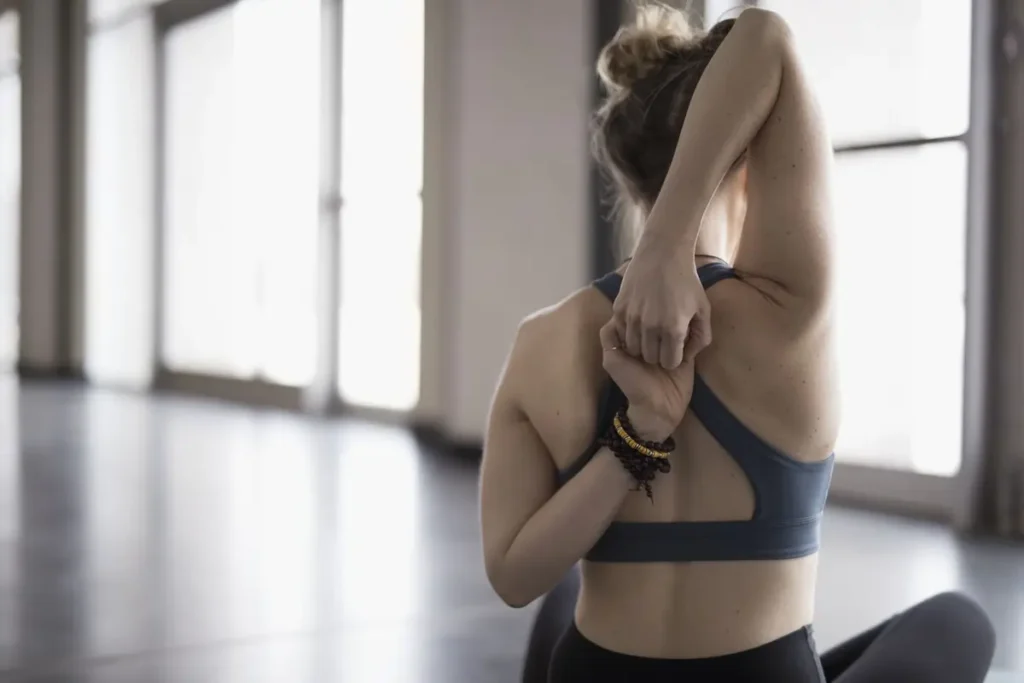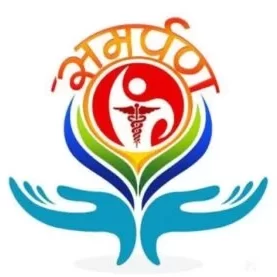Clasp Hands Behind Back Stretch
The Clasp Hands Behind Back Stretch is a simple upper-body stretch that opens the chest, improves shoulder mobility, and helps counteract poor posture caused by long sitting or desk work.
Benefits include improving posture from extended sitting and relieving stress in the neck, biceps, and chest.
Table of Contents
Indication
- Postural correction is ideal for correcting rounded shoulders and forward-leaning heads, which are common among desk workers, drivers, and students.
- Shoulder Mobility: Recommended for improving shoulder extension and flexibility, especially in individuals whose range is limited due to age or inactivity. Stretching stiff pectoral muscles and enhancing thoracic expansion are two benefits of opening the chest that support better breathing mechanics.
- Desk Job Recovery: Counteracts the effects of prolonged sitting and slouched posture to help relieve upper body stress.
- Mobility before and after exercise: This method can be used to warm or cool the shoulder girdle, especially while doing overhead or pushing actions.
- Yoga and rehabilitation: Often included in yoga postures and physiotherapy exercises to promote minor spinal extension and shoulder retraction.
Clasp Hands Behind Back Video
How to do it

- Position: Either seated or standing.
- Draw your knuckles down toward the floor and interlace your fingers behind your back to straighten your arms. Place your hands hip-width apart on a strap or towel (or wider if needed) if you have trouble clasping your hands or are unable to straighten your arms.
- When you take your hands off your butt, you should feel your shoulders extend.
- Five to 10 seconds is the hold time.
- Ten to fifteen repetitions each session are recommended.
Benefit
- Improves posture: improves back muscle and improves spinal mobility
- Improves shoulder mobility: improves the shoulder joint‘s ROM, which helps to reach back and improve overhead activity.
- Tension relief: reduce tension and stiffness in the arms, upper back, shoulders, and chest,
- Improves breathing: Increasing lung capacity and breathing efficiency might result from opening the chest.
- Increases circulation: The stretch may increase blood flow to the shoulder and chest.
- Strengthens muscles: It strengthens the upper back, shoulders, and arms.
Prevention
- Stretching regularly can help prevent shoulder pain in the first place. Frequent exercise is also important. Yoga may reduce stress and tension and increase flexibility.
- When using a computer, use a stand to raise the screen to eye level. This reduces the likelihood of shoulder strain and the need to bend the shoulders and neck.
- Maintaining good posture is also essential. If someone notices they are slouching, the previously mentioned shoulder roll exercise can help straighten the shoulders.
- Maintaining good posture when standing and sitting can help reduce long-term shoulder and neck discomfort, especially when working at a desk for long periods of time. A massage may be beneficial if stretching is useless for relieving a persistent shoulder pain.
FAQs
What are the benefits of hand stretches?
Stretching aims to lengthen the tendons and muscles of the hands and wrists. Examples of repeated jobs that might shorten muscles and create pain and stiffness include typing, using gardening equipment, and working on an assembly line.
Should you stretch your back every day?
Daily stretching improves circulation and reduces stiff muscles, which helps reduce pain in the back. Stretching also improves the strength and agility of muscles. Strong back and abdominal muscles will help reduce pain and the chance of further injuries.
Reference
Prajapati, D. (2025, November 3). Clasp hands behind the back stretch – home physiotherapy. Physiotherapy Treatment and Exercises at Home. https://homephysiotherapyexercises.com/clasp-hands-behind-back-stretch/



